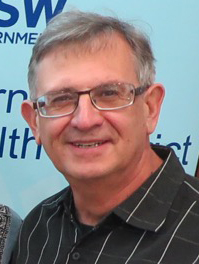The cover of this issue depicts the complex river systems of the Far North Coast. The caput medusae (resulting from an obstruction that leads to engorgement of the upstream vessels) of the Wilson River at Lismore has had repeated, and often unpredicted, severe consequences for decades. The flood waters from this system combine with those of the Richmond River to inundate the other townships downstream. All settlements and much farmland on the North Coast have been affected either directly or indirectly.
On 23 June 2022 NorDocs held its first face to face meeting in almost three years. “Flood Docs” brought together over 60 GPs, specialists, residents, politicians and health administrators from around the region to discuss the devastation of the February-March flood, its aftermath and its effect on the community and the provision of medical care.
Congratulations go to the organising committee of Nathan Kesteven, Dave Glendinning and Sue Velovski, and to master of ceremonies, Peter Silberberg. Special thanks goes to NorDocs administrator, Linda Ward, for all her work in making the meeting such a great success.
While the flood waters are long gone the recovery has just started. The NSW government inquiry into the 2022 floods is to issue its final report at the end of July. On page 13 we look at options for “flood-proofing the towns” and on page 11 note the views of the community already sought by the Commission. One option is to move Lismore out of the flood zone (page 8) but the cost of doing this is said to be over one billion dollars.
Addressing mental health issues is part of the recovery and one that does not require massive infrastructure investment. Art therapy can be an effective treatment as shown by a North Coast survey conducted by University of Western Sydney medical students.
In a similar vein of addressing the mental health of the community through art, Lismore Gallery director, Ashleigh Ralph, speaks with Janet Grist on the efforts being made to restore the gallery to its former glory (page 10).
This year’s Archibald Prize winner was Blak Douglas’ portrait of local artist Karla Dickens (page 5). Blak describes the painting, “Moby Dickens”, as a metaphor for the recent disastrous North Coast floods. Dickens’ previous work featured in NorDocs magazine in February 2021.
New surgical procedures are available on the North Coast. Same day total knee replacement (TKR) is an option for a subset of patients being treated at Grafton Base Hospital under local orthopaedic surgeon, Dr Sam Martin (page 20). Sam examines in more detail what can be achieved in this field on our Youtube channel and advocates for the more widespread availability of same day TKR on the North Coast.
Complementing same day TKR operation is the new procedure of genicular artery embolisation (GAE) for knee pain in the postoperative period, as local vascular surgeons Andrew Drane, Dominic Simring and Anthony Leslie explain on page 22.
The May election has brought a new Labor government to power. On page 15 former health bureaucrat Dr Stephen Duckett has some sage advice for the new Minister. On page 16 we review the changes in the health landscape over the last ten years and the challenges facing the Minister in the years ahead. As with other areas of government policy, changes to health will take more than one three-year term to fully develop and implement.
Labor’s health plan aims to increase GP numbers and improve access to both GPs and specialists.
The previous Coalition government’s Australia’s Primary Health Care 10-Year Plan was released just prior to the election and some of its recommendations are likely to be adopted by the new government.
For general practice Labor foreshadows:
- grants of $25,000 to $50,000 to increase quality care through technology upgrades and upskilling,
- a modified medical home with voluntary patient registration for the elderly to sign up with a GP clinic for the management of long-term, chronic diseases, and
- support for integrated care, allowing people to move more easily from hospital to primary care.
Australian general practice is in freefall (page 31). Increasing specialisation has seen a marked restriction in scope of practice for general practitioners and the demise of the general physician. Years of underfunding general practice rebates has made the discipline a non-viable option for many young graduates.
Research suggests the three things needed to entice young doctors to general practice are to:
- decrease the GP/specialist income gap,
- allow for more procedural work, and
- provide more opportunities for research and academic work.
It seems unlikely that any of this will come to pass soon. Labor has major policies across several domains that it wishes to implement. None of these are cheap and, as with most incoming Treasurers, Jim Chalmers has looked in the cupboard and found it bare.
It seems likely that, for the time being at least, it will be steady as it goes. This might ungenerously be described as the slow process to turn around an oil tanker, or if worst comes to worst, the Titanic approach. We can only hope that the prospects of true health reform will not encounter an iceberg or even the shoals of bureaucratic ineptitude and financial waste.





